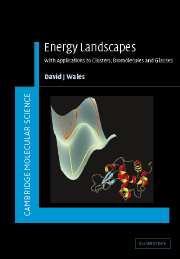Book contents
- Frontmatter
- Contents
- Preface
- 1 Introduction
- 2 The Born–Oppenheimer approximation and normal modes
- 3 Symmetry considerations
- 4 Features of the landscape
- 5 Describing the landscape
- 6 Exploring the landscape
- 7 Properties of the landscape
- 8 Clusters
- 9 Biomolecules
- 10 Glasses and supercooled liquids
- Appendix A Sylvester's law of inertia
- Appendix B Derivation of Ω(E, P, L)
- Index
6 - Exploring the landscape
Published online by Cambridge University Press: 05 October 2013
- Frontmatter
- Contents
- Preface
- 1 Introduction
- 2 The Born–Oppenheimer approximation and normal modes
- 3 Symmetry considerations
- 4 Features of the landscape
- 5 Describing the landscape
- 6 Exploring the landscape
- 7 Properties of the landscape
- 8 Clusters
- 9 Biomolecules
- 10 Glasses and supercooled liquids
- Appendix A Sylvester's law of inertia
- Appendix B Derivation of Ω(E, P, L)
- Index
Summary
In Chapter 4 we discussed features of the potential energy surface such as minima, transition states, pathways and branch points. In this chapter some of the methods employed to locate and characterise these features will be outlined, while Chapter 7 will deal with techniques to calculate thermodynamic and dynamic properties that make explicit use of stationary point information. Other methods for sampling the PES and for calculating thermodynamic and dynamic quantities of interest will be summarised in the present chapter. Depending on the conditions of interest it may also be important to know what lies at the very bottom of the PES, for this is where the system will be found at low temperature if the dynamics permit equilibrium to be attained. Locating this global potential energy minimum is important in many different fields, and a diverse range of approaches have been suggested. Some of these are considered in Section 6.7, where we also discuss why certain potential energy surfaces make the global minimum relatively easy or difficult to locate.
Finding local minima
The field of geometry optimisation involves the location of stationary points on the PES, be they minima, transition states or higher index saddles with more than one negative Hessian eigenvalue (Section 4.1). Many algorithms have been suggested, even for the simplest problem of finding a local minimum, and there are even methods designed to locate branch points (Section 4.4) (1) and conical intersections (Section 2.4.2) (2–4).
- Type
- Chapter
- Information
- Energy LandscapesApplications to Clusters, Biomolecules and Glasses, pp. 283 - 363Publisher: Cambridge University PressPrint publication year: 2004
- 1
- Cited by

